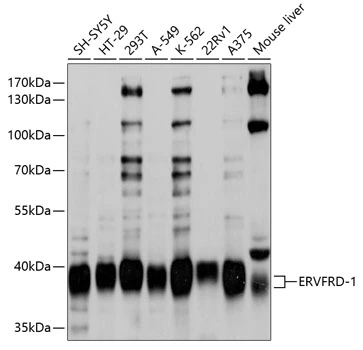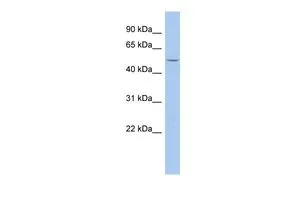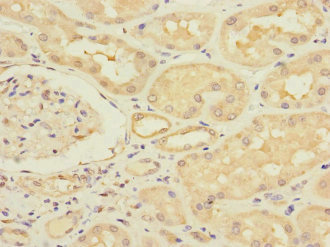
WB analysis of various sample lysates using GTX66051 HERV-FRD antibody. Dilution : 1:1000 Loading : 25microg per lane
HERV-FRD antibody
GTX66051
Overview
- SupplierGeneTex
- Product NameHERV-FRD antibody
- Delivery Days Customer9
- Application Supplier NoteWB: 1:1000 - 1:4000. *Optimal dilutions/concentrations should be determined by the researcher.Not tested in other applications.
- ApplicationsWestern Blot
- CertificationResearch Use Only
- ClonalityPolyclonal
- ConjugateUnconjugated
- Gene ID405754
- Target nameERVFRD-1
- Target descriptionendogenous retrovirus group FRD member 1, envelope
- Target synonymsendogenous retrovirus group FRD, member 1; envelope polyprotein; envFRD; ERVFRDE1; GLLL6191; HERV-FRD; HERV-FRD provirus ancestral Env polyprotein; HERV-FRD_6p24.1 provirus ancestral Env polyprotein; HERV-W/FRD; syncytin 2; syncytin-2; UNQ6191
- HostRabbit
- IsotypeIgG
- Protein IDP60508
- Protein NameSyncytin-2
- Scientific DescriptionMany different human endogenous retrovirus (HERV) families are expressed in normal placental tissue at high levels, suggesting that HERVs are functionally important in reproduction. This gene is part of a human endogenous retrovirus provirus on chromosome 6 that has inactivating mutations in the gag and pol genes. This gene is the envelope glycoprotein gene which appears to have been selectively preserved. The genes protein product plays a major role in placental development and trophoblast fusion. The protein has the characteristics of a typical retroviral envelope protein, including a cleavage site that separates the surface (SU) and transmembrane (TM) proteins which form a heterodimer. [provided by RefSeq, Jun 2012]
- Storage Instruction-20°C or -80°C,2°C to 8°C
- UNSPSC12352203






